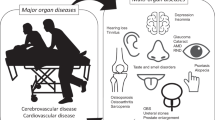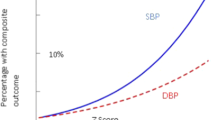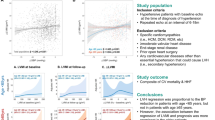Abstract
Hypertension and aging are major independent risk factors for cardiovascular-related morbidity and mortality. Although independent, these two entities are closely related and operate simultaneously to adversely affect the cardiovascular system. In many aspects the morphologic and functional changes that occur in the cardiovascular system with aging and hypertension are similar; both include left ventricular hypertrophy, fibrosis and dysfunction. In this report we briefly summarize the primary pathophysiology of cardiovascular aging and hypertension and describe the clinical and therapeutic impact that hypertension and aging combined have on the cardiovascular system.
Key Points
-
Hypertension and aging are major independent risk factors for cardiovascular-related morbidity and mortality
-
Ventricular enlargement, fibrosis and dysfunction, as well as coronary insufficiency, are features of both hypertension and aging, although it is probable that distinct pathophysiological mechanisms are involved in each process
-
The common clinical manifestations of age-related cardiovascular dysfunctions are hypertension (often only isolated systolic hypertension), coronary vascular insufficiency, left ventricular dysfunction and heart failure of varying degrees
-
A great proportion of elderly patients with heart dysfunction and failure have diastolic dysfunction in a setting of normal or nearly normal ejection fraction
This is a preview of subscription content, access via your institution
Access options
Subscribe to this journal
Receive 12 print issues and online access
$209.00 per year
only $17.42 per issue
Buy this article
- Purchase on Springer Link
- Instant access to full article PDF
Prices may be subject to local taxes which are calculated during checkout
Similar content being viewed by others
References
Chobanian AV et al.; National High Blood Pressure Education Program Coordinating Committee (2003) The seventh report of the Joint National Committee on Prevention, Detection, Evaluation, and Treatment of High Blood Pressure: the JNC 7 Report. JAMA 289: 2560–2571
Lakatta EG and Levy D (2003) Arterial and cardiac aging: major shareholders in cardiovascular disease enterprises. Part II: the aging heart in health: links to heart disease. Circulation 107: 346–354
Assayag P et al. (1997) Senescent heart compared with pressure overload-induced hypertrophy. Hypertension 29: 15–21
Olivetti G et al. (1991) Cardiomyopathy of the aging human heart: myocyte loss and reactive cellular hypertrophy. Circ Res 68: 1560–1568
Kitzman DW (2000) Heart failure with normal systolic function. Clin Geriat Med 16: 489–512
Blacher J and Safar ME (2006) Large artery stiffness and cardiovascular risk: introduction to risk assessment and new strategies. In Handbook of Hypertension. Volume 23: Arterial Stiffness in Hypertension, 241–256 (Eds Safar ME and O'Rourke MF) Amsterdam: Elsevier
Mitchel GF (2004) Arterial stiffness and wave reflection in hypertension: pathophysiologic and therapeutic implication. Curr Hypertens Rep 6: 436–461
Mitchell GF et al. (2004) Changes in arterial stiffness and wave reflection with advancing age in healthy men and women: the Framingham Heart Study. Hypertension 43: 1239–1245
Burt VL et al. (1995) Prevalence of hypertension in the US adult population: results from the Third National Health and Nutrition Examination Survey, 1988–1991. Hypertension 25: 305–313
Kaas DA (2005) Ventricular arterial stiffening: integrating the pathophysiology. Hypertension 46: 185–193
Torella D et al. (2004) Cardiac stem cell and myocyte aging, heart failure, and insulin-like growth factor-1 over-expression. Circ Res 94: 514–524
Lakatta EG (2003) Arterial and cardiac aging: major shareholders in cardiovascular disease enterprises. Part III: cellular and molecular clues to heart and arterial aging. Circulation 107: 490–497
Burlew BS and Weber KT (2000) Connective tissue and the heart. Functional significance and regulatory mechanisms. Cardiol Clin 18: 435–442
Frohlich ED (1990) Left ventricular hypertrophy: an independent factor of risk. Cardiovasc Clin 20: 85–94
Levy D et al. (1987) Risk of ventricular arrhythmias in left ventricular hypertrophy: the Framingham Heart Study. Am J Cardiol 60: 560–565
Kozakova M et al. (2000) Coronary vasodilator capacity and epicardial vessel remodeling in physiological and hypertensive hypertrophy. Hypertension 36: 343–349
Frohlich ED (2001) Fibrosis and ischemia: the real risks in hypertensive heart disease. Am J Hypertens 14: 194S–199S
Weber KT (1989) Cardiac interstitium in health and disease: the fibrillar collagen network. J Am Coll Cardiol 13: 1637–1652
Jugdutt BI (2003) Remodeling of the myocardium and potential targets in the collagen degradation and synthesis pathways. Curr Drug Targets Cardiovasc Haematol Disord 3: 1–30
Spinale F (2002) Matrix metalloproteinasees: regulation and dysregulation in the failing heart. Circ Res 90: 520–530
Swynghedauw B (1999) Molecular mechanisms of myocardial remodeling. Physiol Rev 79: 215–262
Robert V et al. (1997) Differential regulation of matrix metalloproteinases associated with aging and hypertension in the rat heart. Lab Invest 76: 729–738
Shivakumar K et al. (2003) Differential response of cardiac fibroblasts from young adult and senescent rats to ANG II. Am J Physiol Heart Circ Physiol 284: H1454–H1459
Diez-Araya G et al. (2003) IGF-1 modulation of rat cardiac fibroblast behavior and gene expression is age dependent. Cell Commun Adhes 10: 155–165
Lindsey ML et al. (2005) Age-dependent changes in myocardial matrix metalloproteinase/tissue inhibitor of metalloproteinase profiles and fibroblast function. Cardiovasc Res 60: 410–419
Zile MR and Brutsaert DL (2002) New concepts in diastolic dysfunction and heart failure. Part I: diagnosis, prognosis, and measurements of diastolic function. Circulation 105: 1387–1393
Rich MW (2006) Heart failure in older adults. Med Clin North Am 90: 863–885
Katz AM and Zile MR (2006) New molecular mechanism in diastolic heart failure. Circulation 113: 1922–1925
Kitzman DW et al.; Cardiovascular Health Study Research Group (2001) Importance of heart failure with preserved systolic function in patients ≥65 years of age. CHS Research Group. Cardiovascular Health Study. Am J Cardiol 87: 413–419
Susic D et al. (1998) Coronary hemodynamics in aging spontaneously hypertensive and normotensive Wistar-Kyoto rats. J Hypertens 16: 231–237
Csiszar A et al. (2002) Aging induced phenotypic changes and oxidative stress impair coronary arteriolar function. Circ Res 90: 1159–1166
Tomanek RJ (1990) Response of the coronary vasculature to myocardial hypertrophy. J Am Coll Cardiol 15: 528–533
Schiffrin EL (2001) Small artery remodeling in hypertension: can it be corrected? Am J Med Sci 322: 7–11
Folkow B (1995) Hypertensive structural changes in systemic precapillary resistance vessels: how important are they for in vivo hemodynamics? J Hypertens 13: 1546–1559
Zile MR and Brutsaert DL (2002) New concepts in diastolic dysfunction and diastolic heart failure. Part II: causal mechanisms and treatment. Circulation 105: 1503–1508
van Heerebeek L et al. (2006) Myocardial structure and function differ in systolic and diastolic heart failure. Circulation 113: 1966–1973
De Keulanear GW and Brutsaert DL (2007) Systolic and diastolic heart failure: different phenotypes of the same disease? Eur J Heart Fail 9: 136–143
Stokes GS (2006) Treatment of isolated systolic hypertension. Curr Hypertens Rep 8: 377–383
Pinto E (2007) Blood pressure and ageing. Postgrad Med J 83: 109–114
Kumar A et al. (2006) Diastolic heart failure in the elderly and the potential role of aldosterone antagonists. Drugs Aging 23: 299–308
Frohlich ED and Varagic J (2004) The role of sodium in hypertension is more complex than simply elevating arterial pressure. Nat Clin Pract Cardiovasc Med 1: 24–30
Gates PE et al. (2004) Dietary sodium restriction rapidly improves large elastic artery compliance in older adults with systolic hypertension. Hypertension 44: 35–41
Bagrov AY and Lakatta EG (2004) The dietary sodium-blood pressure plot “stiffens”. Hypertension 44: 22–24
Elkareh J et al. (2007) Marinobufagenin stimulates fibroblast collagen production and causes fibrosis in experimental uremic cardiomyopathy. Hypertension 49: 215–224
Taddei S et al. (2006) Endothelium, aging, and hypertension. Curr Hypertens Rep 8: 84–89
Barton M (2005) Ageing as a determinant of renal and vascular disease: role of endothelial factors. Nephrol Dial Transplant 20: 485–490
Kansui Y et al. (2002) Angiotensin II receptor antagonist improves age-related endothelial dysfunction. J Hypertens 20: 439–446
Goto K et al. (2000) Angiotensin-converting enzyme inhibitor prevents age-related endothelial dysfunction. Hypertension 36: 581–587
Wu G and Meininger CJ (2000) Arginine nutrition and cardiovascular function. J Nutr 130: 2626–2629
Susic D et al. (1999) Prolonged L-arginine on cardiovascular mass and myocardial hemodynamics and collagen in aged spontaneously hypertensive rats and normal rats. Hypertension 33: 451–455
Susic D et al. (2001) Isolated systolic hypertension in elderly WKY is reversed with L-arginine and ACE inhibition. Hypertension 38: 1422–1426
Lee AT and Cerami A (1992) Role of glycation in aging. Ann NY Acad Sci 663: 63–70
Susic D et al. (2004) Crosslink breakers: a new approach to cardiovascular therapy. Curr Opin Cardiol 19: 336–340
Susic D et al. (2004) Cardiovascular and renal effects of a collagen cross-link breaker (ALT-711) in adult and aged spontaneously hypertensive rats. Am J Hypertens 17: 328–333
Asif M et al. (2000) An advanced glycation endproduct cross-link breaker can reverse age-related increases in myocardial stiffness. Proc Natl Acad Sci USA 97: 2809–2813
Vaitkevicius PL et al. (2001) A cross-link breaker has sustained effects on arterial and ventricular properties in older rhesus monkeys. Proc Natl Acad Sci USA 98: 1171–1175
Kass DA et al. (2001) Improved arterial compliance by a novel advanced glycation end-product crosslink breaker. Circulation 104: 1464–1470
Bakris GL et al. (2004) Advanced glycation end-product cross-link breakers: a novel approach to cardiovascular pathologies related to the aging process. Am J Hypertens 17: 23S–30S
Little WC et al. (2005) The effect of alagebrium chloride (ALT-711), a novel glucose cross-link breaker, in the treatment of elderly patients with diastolic heart failure. J Card Fail 11: 191–195
Author information
Authors and Affiliations
Corresponding author
Ethics declarations
Competing interests
The authors declare no competing financial interests.
Rights and permissions
About this article
Cite this article
Susic, D., Frohlich, E. The aging hypertensive heart: a brief update. Nat Rev Cardiol 5, 104–110 (2008). https://doi.org/10.1038/ncpcardio1091
Received:
Accepted:
Issue Date:
DOI: https://doi.org/10.1038/ncpcardio1091



